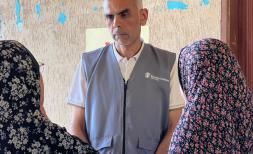5 Things You Didn't Know About Hunger

After decades of progress, the rate of child survival is in reverse for the first time in 20 years. COVID-19, shifts in climate and ongoing conflicts have contributed to a global hunger crisis that is getting rapidly worse. In 2019, the number of people worldwide who were estimated to be undernourished was 690 million, a rise of 60 million in five years. If this trend continues, by 2030 that figure will have risen to 840 million.
We know that hunger is a threat to children around the world. But here are five facts you may not know about hunger.
1. Hunger is a complicated crisis.
It’s not just skipping meals because there’s not enough food to go around – it’s often an inevitability of other crises. Climate change, conflict, and COVID-19 are just three issues that can increase the risk of children going hungry. Floods and droughts, made worse by climate change, can destroy crops and livestock. In Yemen, a country suffering through an intense conflict for the last six years, 70% of the population does not have enough to eat. And due to COVID-19, entire supply chains have been disrupted, causing food prices to spike and making meals unaffordable for millions of people.

Feliza*, 5, wearing a washable mask included in our family hygiene kit, Razal, Philippines
2. Hunger has huge detrimental effects on a child’s mental, as well as physical development.
Language and communications is an essential part of a child’s development. Without these skills, children struggle when they start school – both in terms of their learning and in their social abilities. It can be hard to play with others and to make friends, and unfortunately children without these skills continue to be at a disadvantage as they go through school. However, research shows that hunger impacts this development as nutrients provide the biological building blocks for our organs, including the structural and functional development of the brain. Preventing child malnutrition therefore improves children’s cognitive function, learning capacity and their future outcomes.
3. Schools are the place that children can be guaranteed at least one meal a day.
Earlier this year, UNICEF reported that 370 million children worldwide – many of whom are reliant on school meals as a key source of their daily nutrition – had missed on average 40% of in-school meals since COVID-19 restrictions caused disruption to their schooling. School isn’t just a place for learning – what we call ‘wrap-around’ services like food and healthcare are just as important to a child’s growth and wellbeing. And of course, it’s a place to play with friends. That’s why it’s so important that children get back to school as soon as it’s safe.

Laxmi during a class on good nutrition at her boarding school in Telangana, India
4. Malnutrition is a vicious cycle.
Hunger is linked to almost half of all child deaths. It can weaken the immune system, making children more susceptible to illness, leading to higher rates of child mortality. Undernourished children are more likely to grow into undernourished adults, who in turn are more likely to have undernourished children. So it’s vital that children get treated early, for the sake of their health and their family. Even more important is ending this cycle of malnutrition with long-term political solutions. These solutions, and especially prevention, require dismantling unequal power structures, improving equitable access to health services and nutritious foods, improving water and sanitation, and planning for food shortages and emergencies.
5. It is possible to end hunger.
In the short-term, children with severe acute malnutrition need urgent lifesaving treatment to survive. Until recently children were only treated in hospitals where they received therapeutic milks along with medical care, and many more were never reached at all. But when ready-to-use therapeutic food (RUTF) was created, the picture has changed dramatically.
RUTF is a high-energy, micronutrient enhanced paste used to treat children under age five with severe acute malnutrition. It doesn’t need to be cooked or prepared before consumption, which makes it a practical solution where cooking facilities and fuel are limited. RUTF has a long shelf life and is safe for use even in the absence of clean drinking water. RUTF has transformed the treatment of severe acute malnutrition, as it enables children to be treated in their own homes and communities.
The treatment of severe acute malnutrition is a last opportunity to save a child’s life when all else has failed. But it’s not a substitute for promoting equitable access to nutritious food, ending poverty and supporting other timely interventions that can prevent malnutrition before it starts.
In the long-term, the international community needs to act and act fast to end the hunger crisis. We’re calling on governments to fully fund the Global Humanitarian Response Plan, as well as the numerous other underfunded humanitarian response plans, and support the scale up of social protection schemes and services for children. We’re also asking donors to prioritise humanitarian cash and voucher assistance in order to address hunger, food security, and the increased risks of violence, particularly gender-based violence, caused by the pandemic.
To truly put an end to global hunger, the international community must address the root causes of acute food insecurity. Funding alone will not solve the global hunger crisis, and mitigating the worst effects of COVID-19 is just one part of the solution. Only by putting an end to global conflict, tackling changing climate, and building more resilient communities will we be able to ensure the same warnings are not ringing out again in the coming year
In a world where there is more than enough food for every person, allowing famine to happen is absolutely unnecessary. At Save the Children, we’re working on the ground to support children and fight malnutrition around the world.







